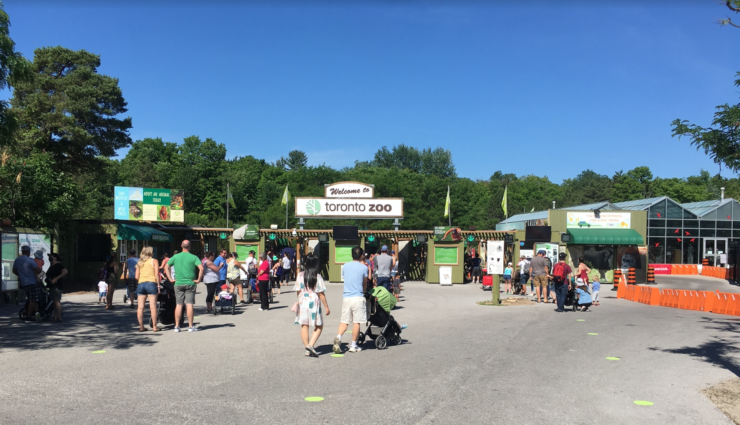HERE’S WHAT ZOOS ARE DOING TO PROTECT THEIR ANIMALS AND SAVE THEIR BUSINESSES
Ontario zoos both big and small cannot maintain financial stability amidst the pandemic. While some zoos do qualify for provincial and federal support, many rely on private donations to take care of their animals.
For example, the family who owns the Brant-Brantford’s Twin Valley Zoo never dreamed that they would one day discuss their zoo’s financial troubles.
Jennifer Stallmann, who manages the zoo on behalf of her mother-in-law, opened up on the struggles.
“At the end of last year we sat at the kitchen table and had very serious conversations about hard [financial] decisions that we would have to make about the future of our zoo.”
According to Stallmann, Twin Valley Zoo is not eligible for federal grants that have been created to alleviate the pandemic’s weight on businesses.
“We are a seasonal business. We are only open for six months out of the year,” she said.
“So, because we don’t have an income for the other six months, on paper it doesn’t [seem like we suffer major economic losses]. This is why we aren’t eligible for government support.”
The Twin Valley Zoo experienced a large economic loss because only a small amount of people are allowed on the property at a time. Meaning, at its current income, the zoo does not generate sufficient revenue to get through the winter months.
However, Stallmann is thankful for Brantford’s generosity during the first province-wide lockdown.
“When the lockdown happened in 2020 we were fortunate because the Brantford community helped us raise money [and] we were able to forge new relationships with different communities, support groups, and sanctuaries.”
Almost one year later, Stallmann wonders if the business can withstand more financial pressures in 2021. She said the family is not confident they can find the support to keep their business afloat for a second year in a row.
“Everyone around us has financial struggles,” said Stallmann. “Some of my friends have lost their businesses and some have even lost homes.”
With an unknown future lying ahead, concern surrounds the business.
“We have no idea what restrictions are around the corner. It’s terrifying for us to go into a second year of this pandemic.”
Social distancing protects zoo animals
In Brantford, a big part of the Twin Valley Zoo is getting close with the animals.
However, because COVID-19 can spread from certain animals to people through close contact (and vice versa), Stallmann’s family no longer allows the public to approach their animals.
Stallmann explained that Twin Valley Zoo adopted health and safety policies that comply with provincial social distancing guidelines.
The Toronto Zoo also adopted similar safety policies at the pandemic’s onset. Not only did the park close indefinitely on Nov. 23, 2020, but the zoo also implemented policies to ensure workers distance from each other and from the animals.
“We had to reduce the number of staff allowed on site to care for our animals,” said Toronto Zoo health and safety manager, Joanne Eaton.
According to Eaton, these new policies will keep both workers and the animals safe.
“[We do this] because we have the added concern that some of our animals are susceptible to COVID-19.”
“Respiratory illnesses can transfer back and forth between certain animals and humans.”
COVID-19, specifically, is a zoonotic disease that is easily transferred to big cats and non-human primates like apes and monkeys. For example, in April 2020, big cats at the Bronx Zoo contracted the virus.
While these animals did recover from the illness, Eaton said the Toronto Zoo wants to avoid this ordeal altogether — hence their strict social distancing policies.
Eaton added, the zoo’s closure and strict social distancing policies are necessary for the safety of the animals, “but this has an enormous impact on our bottom line.”
Reliance on fundraising campaigns
To address their lack of funding, many zoos, like Brantford’s Twin Valley Zoo, have had to turn to fundraising efforts to keep their businesses afloat and their animals cared for.
The Toronto Zoo launched their Zoo Food for Life campaign which aims to “offset lost revenues and ensure funding for the Zoo’s Nutrition Program in 2021.”
The zoo needs to raise at least $1 million just to feed its 5,000 animals for 2021.
Little Ray’s Nature Centres, an Ottawa zoo, is also raising money to compensate for pandemic-related financial losses.
For instance, the zoo started a GoFundMe page with a fundraising goal of $180,000. The zoo also launched the Adopt-An-Animal campaign, where donors can sign-up to give monthly donations.
Lee Parker, a Zoo Director said since the start of the pandemic, “two years of our revenue has been lost due to COVID-19.”
“We have really big overheads that we have to manage,” said Parker. “We have to heat the building, and each of our animals has individual needs. So there are a lot of costs involved in the care for these animals.”
But even with the setbacks, Little Ray’s Nature Centre still continues with their mission.
Parker explained the centre has rescued 80 per cent of the animals they look after and even with the zoo’s financial setbacks continues to take in animals.
“We rescue animals that are abandoned, or who are mistreated. And we also take-in animals that people can no longer take care of for financial reasons.”
Fortunately, the government does provide Little Ray’s with loans but Parker emphasized it isn’t “free money.”
“People have stopped donating as much as they have before because they think the government has taken-over so it’s smooth sailing. But this isn’t the case,” said Parker. “We have to pay back these loans, plus interest, once COVID-19 has subsided.”
Looking ahead, Parker explained Little Ray’s needs all the help it can get.
“It’s hard. The pandemic has severely impacted our business. But we have never ceased to deliver proper care to our animals … and that’s what’s most important.”





